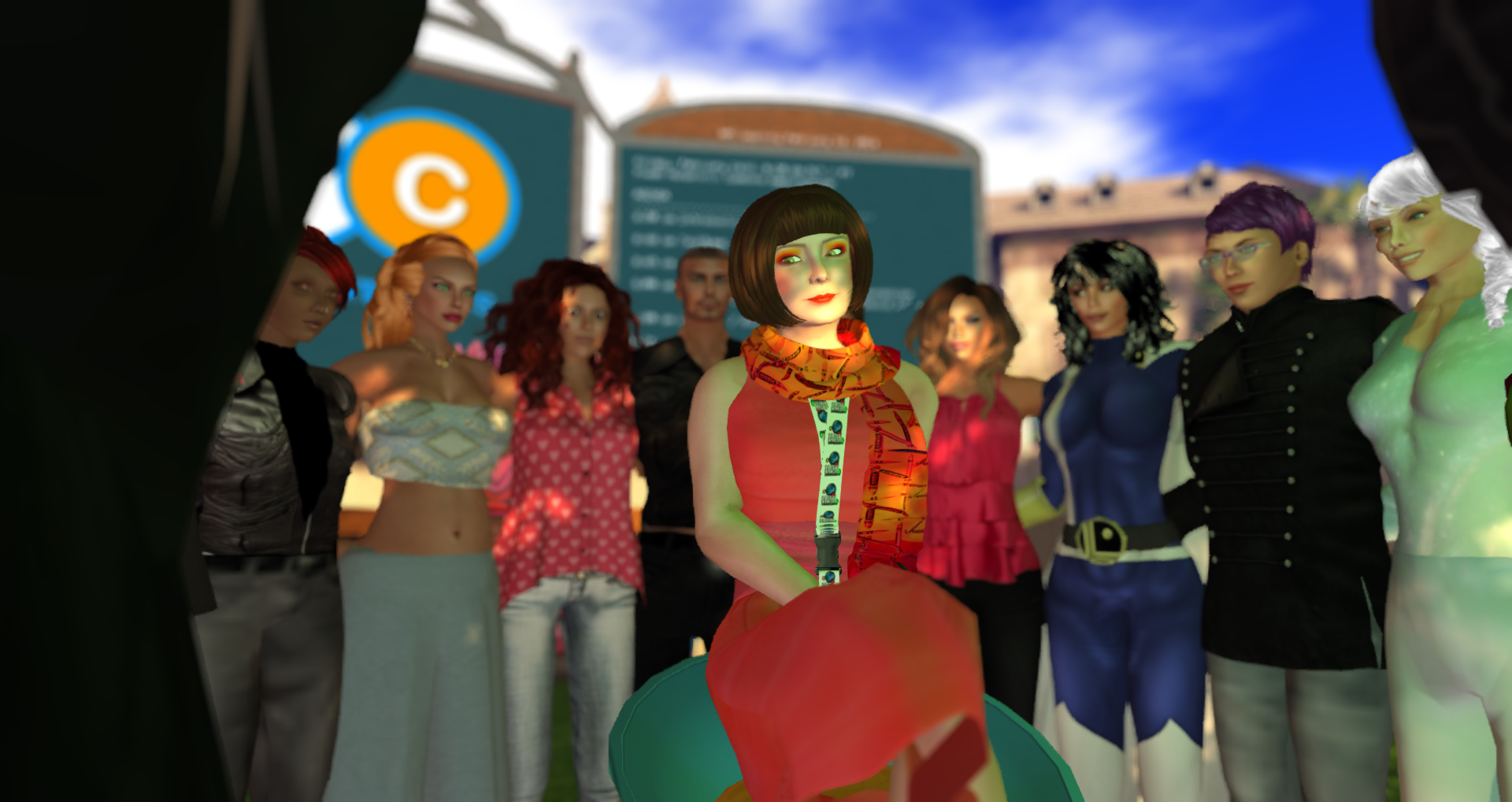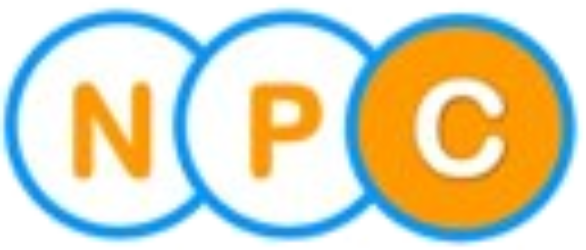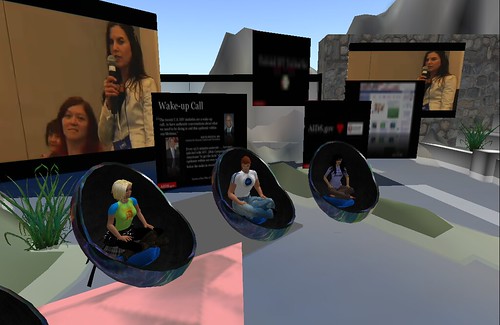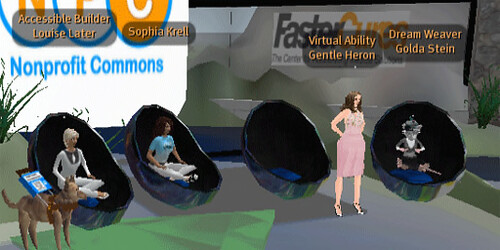[Cross-posting from the NetSquared blog by BJ Wishinsky]
N2Y4 Mixed Reality Health Panel, Wed. May 27, 11:15 AM
 My name is BJ Wishinsky (avatar name Biji Mornington), and I’m the Communities Program Manager at the nonprofit Anita Borg Institute for Women and Technology. I had so much fun live-blogging the mixed reality at last year’s NetSquared conference that I volunteered to do it again today. There are Health Panels all day today in Second Life, celebrating the launch of the new inworld Health Commons. The 11:15 panel on Mobile Health Information is mixed reality: Second Life and Real Life (here at Cisco’s Vineyard Conference Center in San Jose, CA). We’re about to begin, so stay tuned.
My name is BJ Wishinsky (avatar name Biji Mornington), and I’m the Communities Program Manager at the nonprofit Anita Borg Institute for Women and Technology. I had so much fun live-blogging the mixed reality at last year’s NetSquared conference that I volunteered to do it again today. There are Health Panels all day today in Second Life, celebrating the launch of the new inworld Health Commons. The 11:15 panel on Mobile Health Information is mixed reality: Second Life and Real Life (here at Cisco’s Vineyard Conference Center in San Jose, CA). We’re about to begin, so stay tuned.
Seth Gonzales (Avatar Impeccably Peccable) is the Communities Manager for the Boomer Esiason Foundation in New York. They started their SecondLife presence with the long-term goal of starting an inworld community of Cystic Fibrosis (CF) patients. SecondLife can provide CF patients an opportunity to interact with each other without the risk of infection. They are also using SecondLife and mobile technology to engage donors. Donors can give via mobile up to four times a month. The text-to-donate program was launched this month because May is Cystic Fibrosis Awareness Month. 263 million people in the U.S. have cell phones so they want to tap into this group. Seth is confident this will be a sustainable program that helps tremendously with fundraising. They just started it and are getting some good responses using promotional PSAs to get the word out.
Our multiple venues in real life and Second Life are starting to fill up, and Susan Tenby (whose avatar is named Glitteractica Cookie) is explaining the format for our new arrivals. Susan asks Seth about the unique opportunity of the Second Life environment for CF patients. CF patients usually are taking 10-20 pills a day and going through multiple treatments from nebulizers to vibrating vests to keep their lungs clear and stay alive. They often live very isolated lives, between treatments and the need to keep them from being exposed to other infectious diseases that can aggravate their CF and prove fatal. Second Life provides an opportunity for them to meet safely in Second Life and connect with other CF patients for support and socializing.
Their measure of success is getting CF patients acclimated (with a SecondLife 101 class) and familiarizing them with what they offer on Boomer Island.
Jessica Dally of Community Voicemail, works for a nonprofit that provides voice mailboxes to people who are homeless and don’t have their own home or cell. This allows those who are homeless to better keep in touch with their families and friends, and for those who care about them to be able to reach them. It also allows Community Voicemail to get important messages out to clients, for example, about the peanut butter recall, or an approaching hurricane. They are also partnering with AIDS.gov in Second Life and using voicemail and mobile technology to help them disseminate information about HIV testing. In Second Life they partner with other organizations and help them set up voicemail programs with their communities. Second Life helps them spread the word about what they’re doing and partnering with other cities and agencies.
Ellehcim Fizzle (speaking from inworld) of AIDS.gov is talking about the stigma of AIDS and the need to continue to pay attention to AIDS/HIV. One in five people who are infected with HIV are unaware of their status, which underscores the importance of Testing Day. They’re still determining all that they want to do in Second Life. They’re using mobile technology for the KNOWIT campaign where you can text 566948 (KNOWIT) with your zip code and receive information on an testing facility in your area. At the CDC Conference a few months ago she heard about how Community Voicemail was used to reach homeless people regarding the peanut recall and thought it would be a great way to reach the homeless community with information about HIV testing. They are also highlight videos created by partners like Kaiser Family Foundation, MTV and others to help promote testing day.
About 15 of the people here in the room with me are also currently present as avatars at the event in Second Life (SL). Our host, Cisco, has provided great support for all these people running the graphics-intensive Second Life application over the conference wireless. We’re starting some Q&A — microphone in the room, text chat in SL. Jessica (Kali Idziak in SL) notes there was a bit of a steep learning curve for her getting started in SL since she was not a gamer, but there are lots of people and resources to help you learn. She notes that you don’t have to be a techie to learn your way around in SL.
How do nonprofits get started? Come to the weekly inworld Nonprofits in Second Life meetings (http://nonprofitcommons.org/ for info). There’s a meeting every Friday at 8:30 a.m. SLT (Second Life Time, which is Pacific Time).
Susan introduces Jeska Dzwigalski (avatar name Jessica Linden), Director of Communities at Linden Labs. Jessica says recommends telling your boss that IBM saved $320k in Second Life. She recommends also looking at some of the case studies at http://secondlife.com. Some groups in Second Life where you can find help: Virtual Ability (http://virtualability.org/) helps people with disabilities and Wiki Tecture helps people work on their 3D spaces.
The NetSquared Conference is a program of TechSoup, which also offers discounted technology to nonprofits through their TechSoup Stock program. TechSoup Stock is actively working to get more software partners to offer discounted products to health-related nonprofits.
Written by: penguin kuhn







 My name is BJ Wishinsky (avatar name Biji Mornington), and I’m the Communities Program Manager at the nonprofit
My name is BJ Wishinsky (avatar name Biji Mornington), and I’m the Communities Program Manager at the nonprofit 
 SAN FRANCISCO—May 26, 2009—The Nonprofit Commons, a project of TechSoup Global (TSG), today announced an all-day, innovative online event in Second Life to showcase recent developments in health care research, and to connect efforts in fighting disease and creating a cooperative and supportive environment for patients and their providers. The Health Panel Expo, an international online conference sponsored by
SAN FRANCISCO—May 26, 2009—The Nonprofit Commons, a project of TechSoup Global (TSG), today announced an all-day, innovative online event in Second Life to showcase recent developments in health care research, and to connect efforts in fighting disease and creating a cooperative and supportive environment for patients and their providers. The Health Panel Expo, an international online conference sponsored by 

